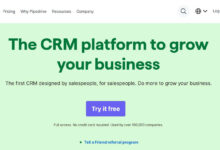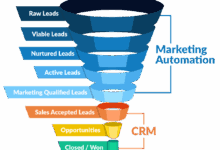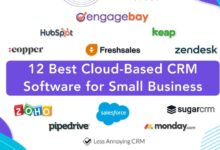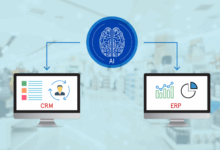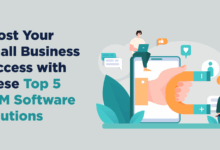Best Enterprise CRM Solutions: A Comprehensive Guide
Best Enterprise CRM Solutions are crucial for businesses aiming for streamlined operations and enhanced customer relationships. This guide delves into the intricacies of selecting, implementing, and maximizing the return on investment from an enterprise-grade CRM system. We’ll explore leading vendors, key features, integration challenges, security considerations, and future trends shaping this vital business technology.
From defining your specific enterprise needs to navigating the complexities of implementation and ensuring user adoption, we provide a practical framework for making informed decisions. Understanding the nuances of different deployment models (cloud, on-premise, hybrid), pricing structures, and customization options is essential for success. We’ll also highlight the importance of data security and compliance, emphasizing best practices for protecting sensitive customer information.
Defining Enterprise CRM Needs
Selecting the right enterprise CRM system is crucial for streamlining operations and driving business growth. A poorly chosen system can lead to decreased efficiency and wasted resources. Understanding the specific needs of your enterprise is the first step towards finding a successful solution.
Choosing an enterprise CRM differs significantly from selecting a solution for a small business. Enterprise-level systems must handle vastly larger amounts of data, integrate with a wider range of applications, and support complex workflows involving numerous users and departments. They often require robust security features and scalability to accommodate future growth.
Core Functionalities of Enterprise CRM Systems
Enterprise CRM systems must provide a comprehensive suite of functionalities to manage customer interactions effectively across the entire organization. These core functionalities typically include contact management, sales force automation, marketing automation, customer service and support, and reporting and analytics. Advanced systems may also incorporate features like predictive analytics, business intelligence dashboards, and integration with other enterprise resource planning (ERP) systems. Effective implementation requires careful planning and consideration of how these functionalities will support the organization’s unique business processes.
Key Differences Between Enterprise and Small Business CRM Solutions
The differences between enterprise and small business CRM solutions are significant and go beyond simply the number of users. Small business CRMs often focus on basic contact management, sales tracking, and rudimentary reporting. Enterprise solutions, however, demand far greater scalability, security, customization, and integration capabilities. They often involve sophisticated workflows, complex data structures, and integration with numerous other business systems. For example, a small business might use a simple CRM to track leads and manage customer interactions, while a large corporation might leverage a comprehensive system to manage its entire sales pipeline, marketing campaigns, customer service interactions, and supply chain. The level of customization and integration required also differs greatly, with enterprise solutions needing to seamlessly integrate with existing systems like ERP and marketing automation platforms.
Comparison of CRM Deployment Models
The choice of deployment model (cloud, on-premise, or hybrid) significantly impacts cost, security, control, and scalability. Each model presents unique advantages and disadvantages.
| Feature | Cloud | On-Premise | Hybrid |
|---|---|---|---|
| Cost | Typically lower upfront costs, subscription-based | Higher upfront investment in hardware and software | Moderate upfront cost, ongoing subscription fees for cloud components |
| Scalability | Highly scalable, easily adjust resources as needed | Requires significant planning and investment for scaling | Scalable, but requires careful planning for cloud and on-premise components |
| Security | Relies on the vendor’s security infrastructure | Greater control over security, but requires significant investment in security measures | Combines security measures of both cloud and on-premise environments |
| Customization | Limited customization options compared to on-premise | High degree of customization | Moderate customization, balancing cloud limitations with on-premise flexibility |
Top Enterprise CRM Vendors
Choosing the right enterprise CRM solution is crucial for business success. The market offers a wide array of options, each with its own strengths and weaknesses. Selecting the best fit depends heavily on specific business needs, size, and industry. This section highlights some leading vendors and explores their pricing and capabilities.
Leading Enterprise CRM Vendors
Several vendors dominate the enterprise CRM landscape. These companies offer comprehensive solutions catering to diverse business requirements, from small to large enterprises. Key players include Salesforce, Microsoft Dynamics 365, SAP CRM, Oracle Siebel CRM, and Zoho CRM. Each vendor provides a unique set of features and functionalities. The optimal choice often depends on a company’s specific needs and existing IT infrastructure.
Pricing Models of Major Vendors
Enterprise CRM pricing is rarely straightforward and often depends on various factors including the number of users, modules selected, customization requirements, and support level. Three major vendors illustrate this complexity:
- Salesforce: Salesforce employs a subscription-based model. Pricing varies significantly based on the edition (Sales Cloud, Service Cloud, etc.), the number of users, and add-on features. Smaller businesses might start with a basic plan costing a few hundred dollars per month, while large enterprises can spend tens of thousands monthly on fully customized solutions with extensive support and integration.
- Microsoft Dynamics 365: Similar to Salesforce, Microsoft Dynamics 365 uses a subscription model. Pricing is tiered, offering different licensing options for various modules (Sales, Customer Service, Marketing, etc.). The cost depends on the number of users, chosen modules, and cloud storage needs. A smaller business might pay a few hundred dollars monthly, while larger organizations may spend considerably more for comprehensive deployments.
- SAP CRM: SAP CRM’s pricing is often more complex and usually involves a combination of upfront licensing fees and ongoing maintenance and support costs. It’s less subscription-based than Salesforce or Dynamics 365 and often involves a significant initial investment. The total cost depends on the specific modules implemented, customization needs, and ongoing support requirements. Pricing for large enterprises can run into hundreds of thousands of dollars annually.
Salesforce, Microsoft Dynamics 365, and SAP CRM: A Comparison
These three vendors represent significant players in the enterprise CRM market, each with its strengths and weaknesses:
| Feature | Salesforce | Microsoft Dynamics 365 | SAP CRM |
|---|---|---|---|
| Strengths | Extensive AppExchange ecosystem, strong customization capabilities, robust reporting and analytics. | Seamless integration with other Microsoft products, user-friendly interface, strong customer support. | Deep integration with other SAP enterprise applications, robust functionality for large enterprises, strong in specific industries. |
| Weaknesses | Can be expensive, complex implementation, steep learning curve for some users. | Less flexible customization compared to Salesforce, some features might require additional add-ons. | Can be complex and expensive to implement and maintain, less user-friendly than Salesforce or Dynamics 365. |
Key Features and Functionality
Choosing the right enterprise CRM hinges on understanding its core features and how they contribute to overall business success. A robust system offers far more than just contact management; it streamlines operations, improves customer relationships, and drives revenue growth. The following sections detail key aspects of functionality essential for effective enterprise CRM deployment.
Integration Capabilities
Seamless integration is paramount for an enterprise CRM’s effectiveness. A siloed system, unable to communicate with other crucial business applications, creates data inconsistencies and hinders workflow efficiency. Successful integration allows for the smooth flow of information between the CRM and systems like ERP (Enterprise Resource Planning), marketing automation platforms, e-commerce solutions, and customer support ticketing systems. For example, integrating with an ERP system allows for real-time updates on inventory levels, order status, and customer purchase history, enriching the customer profile within the CRM and enabling personalized interactions. Similarly, integration with marketing automation tools allows for targeted campaigns based on CRM data, enhancing campaign effectiveness and ROI. A lack of integration leads to duplicated data entry, increased error rates, and a fragmented view of the customer, ultimately impacting decision-making and hindering growth.
Advanced Analytics and Reporting
Advanced analytics and reporting transform raw data into actionable insights, enabling data-driven decision-making. Enterprise CRMs equipped with robust analytical capabilities offer a comprehensive view of customer behavior, sales performance, marketing campaign effectiveness, and overall business trends. This includes features like predictive analytics, which can forecast future sales, identify potential churn risks, and optimize resource allocation. For instance, analyzing sales data can reveal which products are performing well, which sales channels are most effective, and which customer segments are most profitable. This allows businesses to refine their strategies, target high-value customers more effectively, and improve overall sales performance. Without robust analytics, organizations rely on intuition and guesswork, potentially missing opportunities for growth and efficiency.
Essential Features for Managing Customer Interactions, Sales Processes, and Marketing Campaigns
A powerful enterprise CRM should provide a comprehensive suite of tools to manage all aspects of customer interactions, sales processes, and marketing campaigns. These features work in concert to create a cohesive and efficient system.
- Contact Management: Centralized database for storing and managing customer information, including contact details, interaction history, and purchase history. This allows for personalized communication and improved customer service.
- Sales Force Automation (SFA): Tools to automate sales processes, such as lead management, opportunity tracking, and sales forecasting. This improves sales efficiency and accelerates the sales cycle.
- Marketing Automation: Features to automate marketing tasks, such as email marketing, social media management, and campaign tracking. This enables targeted campaigns and improves marketing ROI.
- Customer Service Management: Tools to manage customer inquiries and resolve issues efficiently, such as ticketing systems and knowledge bases. This improves customer satisfaction and loyalty.
- Workflow Automation: Customizable workflows to automate repetitive tasks and streamline business processes. This increases efficiency and reduces errors.
- Reporting and Analytics: Comprehensive dashboards and reports to track key metrics and gain insights into business performance. This enables data-driven decision-making and continuous improvement.
- Collaboration Tools: Features that facilitate communication and collaboration among sales, marketing, and customer service teams. This improves teamwork and enhances customer experience.
Implementation and Integration
Implementing a new enterprise CRM system is a significant undertaking, requiring careful planning, execution, and ongoing management. Success hinges on a well-defined strategy that addresses data migration, system integration, user training, and ongoing support. A phased approach, focusing on incremental improvements and continuous feedback, is often the most effective strategy.
The process involves several key stages, each with its own set of challenges and considerations. These stages are interconnected, and a failure in one area can negatively impact the overall success of the implementation. Careful attention to detail and proactive risk management are crucial throughout the entire process.
CRM Implementation Process
Implementing a new enterprise CRM system typically follows a structured methodology. This might involve phases such as project initiation, requirements gathering, system selection, design and configuration, data migration, testing, deployment, training, and go-live support. Each phase requires specific activities and deliverables to ensure a smooth transition. For example, the requirements gathering phase necessitates a thorough understanding of business processes and user needs to tailor the CRM system effectively. Subsequently, the system selection phase involves evaluating different vendors and solutions based on predefined criteria. Rigorous testing and user acceptance testing (UAT) are crucial before the system goes live to identify and resolve any potential issues.
Challenges of CRM Integration with Existing Enterprise Systems
Integrating a new CRM system with existing enterprise systems like ERP (Enterprise Resource Planning), marketing automation platforms, and other business applications presents significant challenges. These challenges often stem from differences in data structures, formats, and APIs (Application Programming Interfaces). Data inconsistencies, incompatible data models, and the need for real-time data synchronization can lead to integration complexities. For example, integrating a CRM with an ERP system requires mapping customer data fields and ensuring consistent data updates across both systems. Failure to address these challenges can result in data silos, inaccurate reporting, and reduced efficiency. A well-defined integration strategy, utilizing appropriate integration tools and technologies, is essential to mitigate these risks.
Data Migration from Legacy Systems
Migrating data from legacy systems to a new CRM platform is a critical step in the implementation process. This process requires careful planning and execution to ensure data accuracy, completeness, and consistency. A typical approach involves several key steps: data assessment, data cleansing, data transformation, data migration, and data validation. Data assessment involves analyzing the data residing in legacy systems to identify its structure, quality, and completeness. Data cleansing addresses inconsistencies, inaccuracies, and duplicates in the data. Data transformation involves converting data from its legacy format to the format required by the new CRM system. Finally, data validation ensures the accuracy and integrity of the migrated data. This process may involve employing ETL (Extract, Transform, Load) tools and processes. For instance, a company migrating from a spreadsheet-based system to a cloud-based CRM might need to cleanse inconsistent data entries, standardize address formats, and transform date formats before importing the data. Thorough testing is crucial at each stage to prevent data loss or corruption.
Security and Compliance
In the realm of enterprise CRM, robust security and unwavering compliance are paramount. The sensitive nature of customer data, coupled with the increasing sophistication of cyber threats, necessitates a proactive and comprehensive approach to safeguarding information and adhering to relevant regulations. Failure to do so can result in significant financial losses, reputational damage, and legal repercussions.
Data security and privacy are fundamental to maintaining customer trust and ensuring the long-term success of any business utilizing a CRM system. A breach can expose sensitive customer information, leading to identity theft, financial fraud, and erosion of brand loyalty. Similarly, non-compliance with regulations can result in hefty fines and legal battles.
Common Security Threats and Vulnerabilities
Enterprise CRM systems, while offering numerous benefits, are unfortunately susceptible to various security threats. These vulnerabilities can be exploited by malicious actors to gain unauthorized access to sensitive data or disrupt business operations. Understanding these threats is crucial for implementing effective security measures.
- Phishing Attacks: These attacks often involve deceptive emails or websites designed to trick users into revealing their login credentials or other sensitive information. A successful phishing attack can grant attackers access to the entire CRM system.
- SQL Injection: This technique involves inserting malicious SQL code into input fields to manipulate database queries and potentially gain access to sensitive data. This can allow attackers to read, modify, or delete data within the CRM system.
- Malware and Viruses: Malicious software can infect CRM systems through various means, such as email attachments or infected websites. This malware can steal data, disrupt operations, or even hold the system hostage through ransomware attacks.
- Insider Threats: Employees with access to the CRM system can pose a significant security risk. Accidental or malicious actions by insiders can lead to data breaches or system disruptions.
- Weak Passwords and Authentication: Using weak or easily guessable passwords, combined with inadequate authentication mechanisms, can make the CRM system vulnerable to brute-force attacks or credential stuffing.
Compliance Requirements and CRM Solutions
Various regulations worldwide mandate the protection of personal data. Enterprise CRM solutions must be designed and implemented to comply with these regulations to avoid legal penalties and maintain customer trust.
- GDPR (General Data Protection Regulation): This EU regulation requires organizations to obtain explicit consent for data processing, provide individuals with access to their data, and ensure data security. CRMs compliant with GDPR offer features such as data encryption, access control, and data portability tools.
- CCPA (California Consumer Privacy Act): This California law grants consumers the right to access, delete, and opt-out of the sale of their personal data. CRMs that comply with CCPA provide functionalities to facilitate these rights, including data subject access requests and mechanisms to prevent data sales.
- HIPAA (Health Insurance Portability and Accountability Act): For organizations in the healthcare industry, HIPAA requires strict security measures to protect patient health information. HIPAA-compliant CRMs offer features like audit trails, access controls based on roles, and encryption to meet these stringent requirements.
Scalability and Customization
Enterprise CRM solutions must adapt to the ever-changing needs of a business. This necessitates systems that can seamlessly scale to accommodate growth while also offering robust customization options to align with unique workflows and processes. Choosing a CRM that excels in both scalability and customization is crucial for long-term success and return on investment.
Scalability in enterprise CRM refers to the system’s ability to handle increasing amounts of data, users, and transactions without experiencing performance degradation. This involves the capacity to add more users, manage larger datasets, and integrate with a wider range of applications as the business expands. Customization, on the other hand, focuses on adapting the CRM’s functionality to match specific business requirements, ensuring the system effectively supports unique processes and workflows.
CRM Scalability Options
Enterprise CRM systems offer several mechanisms to ensure scalability. These range from infrastructure-level solutions like cloud-based deployments to platform-specific features that enhance processing power and data handling.
- Cloud-Based Deployments: Cloud-based CRMs offer inherent scalability. As your business grows, you can easily increase storage, processing power, and user licenses with minimal disruption. This eliminates the need for significant upfront investment in hardware and IT infrastructure.
- Vertical Scaling: This involves upgrading the resources of your existing CRM server, such as increasing RAM, CPU power, or storage capacity. This approach is suitable for moderate growth but can become expensive and complex for substantial expansions.
- Horizontal Scaling: This involves adding more servers to your CRM infrastructure, distributing the workload across multiple machines. This approach offers superior scalability for significant growth and can handle large volumes of data and users effectively. Amazon Web Services (AWS) and Microsoft Azure provide robust platforms for horizontal scaling.
CRM Customization Methods
Customization allows businesses to tailor their CRM to fit their unique processes. This can be achieved through various methods, including configuration, APIs, and third-party integrations.
- Configuration: Many CRMs offer built-in configuration options that allow users to adjust settings, workflows, and fields without requiring coding. This is often the easiest and most cost-effective method for basic customizations.
- APIs (Application Programming Interfaces): APIs provide a programmatic way to integrate the CRM with other applications and systems, or to extend its functionality. This allows for highly customized solutions, integrating CRM data with other business tools like marketing automation platforms or ERP systems. For example, a company could use an API to automatically update inventory levels in their ERP system whenever a sale is recorded in the CRM.
- Third-Party Integrations: Numerous third-party applications and services integrate with popular CRMs, providing additional features and functionality. These integrations can extend the CRM’s capabilities without requiring extensive custom development. Examples include marketing automation tools (like HubSpot or Marketo), e-commerce platforms (like Shopify or Magento), and business intelligence dashboards (like Tableau or Power BI).
Examples of CRM Customization
Consider a manufacturing company using a CRM to manage customer relationships and track orders. They might use the API to integrate their CRM with their manufacturing execution system (MES) to automatically update order statuses based on production progress. This eliminates manual data entry and ensures real-time visibility into the production pipeline. Another example involves a retail business leveraging a third-party integration to connect their CRM with their e-commerce platform, enabling seamless customer data synchronization across online and offline channels. This enhances the customer experience and allows for personalized marketing campaigns.
Return on Investment (ROI)
Implementing an enterprise CRM system represents a significant investment. Understanding and maximizing the return on that investment is crucial for justifying the expenditure and ensuring the project’s success. This section outlines key metrics for measuring ROI, methods for calculating the total cost of ownership (TCO), and best practices for optimizing returns.
Key Metrics for Measuring CRM ROI
Measuring the ROI of an enterprise CRM implementation requires a multifaceted approach, tracking both hard and soft benefits. Key performance indicators (KPIs) should be carefully selected to align with specific business goals.
- Increased Sales Revenue: Track the direct impact of CRM on sales growth, comparing pre- and post-implementation figures. This might involve analyzing closed-won deals attributed to improved lead management or sales process efficiency.
- Improved Sales Cycle Length: Measure the time it takes to close a deal from initial contact to final sale. A reduction in sales cycle length directly translates to faster revenue generation and improved cash flow.
- Enhanced Customer Satisfaction: Monitor customer satisfaction scores (CSAT) and Net Promoter Score (NPS) to gauge the impact of improved customer service and personalized interactions facilitated by the CRM system.
- Reduced Customer Churn: Track the rate at which customers stop doing business with the company. A lower churn rate indicates increased customer loyalty and retention, leading to sustained revenue streams.
- Improved Sales Productivity: Measure sales representative productivity by tracking metrics such as the number of leads contacted, deals closed, and revenue generated per representative. CRM systems often streamline processes, leading to increased productivity.
- Reduced Operational Costs: Analyze areas where the CRM system has reduced operational expenses, such as decreased manual data entry, improved marketing campaign efficiency, or optimized customer support processes.
Calculating Total Cost of Ownership (TCO)
Calculating the TCO for different CRM solutions involves considering both upfront and ongoing costs. This allows for a comprehensive comparison of various options and informed decision-making.
- Software Licensing Costs: This includes the initial purchase price and any recurring subscription fees.
- Implementation Costs: This encompasses costs associated with project management, customization, data migration, training, and integration with other systems.
- Hardware Costs: If on-premise deployment is chosen, this includes the cost of servers, storage, and network infrastructure.
- Maintenance and Support Costs: This covers ongoing maintenance, technical support, and software updates.
- Training Costs: This includes the cost of training employees on how to use the CRM system effectively.
- Data Migration Costs: The cost of transferring existing customer data into the new CRM system.
A simple TCO calculation might look like this:
TCO = Initial Software Cost + Implementation Costs + Annual Maintenance Costs + Annual Support Costs + Hardware Costs (if applicable)
For example, a company might estimate an initial software cost of $50,000, implementation costs of $20,000, annual maintenance of $10,000, and annual support of $5,000. Over five years, the TCO would be $175,000. This calculation should be adjusted for each specific CRM solution and company context.
Best Practices for Maximizing CRM ROI
Realizing the full potential of an enterprise CRM system requires strategic planning and ongoing optimization. Key best practices include:
- Clearly Defined Objectives: Establish clear, measurable, achievable, relevant, and time-bound (SMART) goals for the CRM implementation. This ensures that the system is aligned with overall business objectives.
- Thorough User Training: Invest in comprehensive training programs to ensure that employees understand how to use the system effectively. Proper training maximizes user adoption and minimizes errors.
- Data Quality and Management: Maintain high data quality within the CRM system. Accurate and up-to-date data is essential for informed decision-making and effective marketing campaigns.
- Regular System Monitoring and Optimization: Continuously monitor key performance indicators (KPIs) and make adjustments as needed to optimize the system’s performance and maximize ROI.
- Integration with Other Systems: Integrate the CRM system with other business applications, such as marketing automation, ERP, and e-commerce platforms, to streamline workflows and improve data consistency.
- Continuous Improvement: Regularly review and refine processes to identify areas for improvement and enhance the overall effectiveness of the CRM system.
User Adoption and Training
Successful enterprise CRM implementation hinges critically on user adoption. Without widespread and consistent use, the system’s potential benefits – improved customer relationships, streamlined processes, and enhanced data analysis – remain unrealized. High adoption rates translate directly into a higher return on investment (ROI) and a more positive impact on the organization’s overall efficiency and profitability.
A comprehensive training program is essential for achieving high user adoption. Effective training goes beyond simple software demonstrations; it fosters a deep understanding of the CRM’s functionality and its alignment with individual roles and organizational goals. This understanding empowers users to confidently leverage the system’s capabilities and actively participate in its ongoing success.
Comprehensive Training Program Design
A multi-faceted approach is necessary for effective CRM training. This includes initial onboarding, ongoing reinforcement, and readily accessible support resources. The training should be tailored to different user roles and skill levels, recognizing that not all employees will require the same depth of knowledge or the same type of training materials. For example, sales representatives might require in-depth training on lead management and opportunity tracking, while customer service representatives might focus on case management and communication tools.
Training Methodology and Materials
The training should incorporate a variety of methods to cater to diverse learning styles. This could include instructor-led classroom sessions, online modules, interactive tutorials, and hands-on workshops. Materials should be readily available in various formats, including videos, presentations, and quick reference guides. Regular quizzes and assessments can help reinforce learning and identify areas where additional support is needed. The use of gamification techniques, such as points and leaderboards, can also help boost engagement and motivation during the training process.
Encouraging User Engagement and Ongoing Adoption
Sustained user engagement requires ongoing support and reinforcement. This can involve regular updates, newsletters, and knowledge base articles that highlight new features and best practices. Establishing a dedicated CRM support team that is readily available to answer questions and provide assistance is crucial. Regular feedback sessions and user surveys can help identify areas for improvement and ensure the training program remains relevant and effective. Celebrating successes and recognizing individuals who effectively utilize the CRM can further encourage positive user behavior and reinforce the value of the system. Furthermore, integrating the CRM system with other existing tools used daily by employees can promote seamless workflow and reduce friction, which increases user adoption. A clear demonstration of how the CRM improves daily tasks and contributes to overall organizational goals is key to ongoing user engagement.
Future Trends in Enterprise CRM
The landscape of enterprise CRM is constantly evolving, driven by technological advancements and shifting business needs. Understanding emerging trends is crucial for businesses aiming to leverage CRM for optimal efficiency and growth. The future of CRM is inextricably linked to advancements in artificial intelligence, machine learning, and data analytics, promising more intelligent and proactive systems.
The integration of AI and machine learning is rapidly transforming enterprise CRM, leading to more sophisticated capabilities and improved decision-making. This evolution moves beyond simple data storage and retrieval towards predictive analytics and automated processes, significantly impacting customer interactions and business operations.
AI-Powered Predictive Analytics
AI and machine learning algorithms are enabling CRM systems to analyze vast amounts of customer data to predict future behavior, such as churn risk or potential upselling opportunities. For instance, a telecom company might use AI to identify customers likely to switch providers based on their usage patterns and recent customer service interactions, allowing proactive interventions to retain them. This predictive capability allows businesses to personalize their offerings and tailor their strategies for maximum impact. The result is improved customer retention, increased sales, and a more efficient allocation of resources.
Hyper-Personalization and Customer Experience
AI facilitates hyper-personalization by enabling CRM systems to tailor customer interactions based on individual preferences and past behavior. Imagine an e-commerce platform using AI to recommend products relevant to a specific customer’s browsing history and purchase patterns, leading to a more engaging and satisfying shopping experience. This level of personalization strengthens customer relationships and drives loyalty. The challenge lies in managing the ethical implications of data usage and ensuring transparency with customers.
Automation and Robotic Process Automation (RPA)
RPA is automating repetitive tasks within the CRM workflow, freeing up human agents to focus on more complex and strategic activities. Tasks like data entry, lead qualification, and appointment scheduling can be automated, resulting in increased efficiency and reduced operational costs. For example, a sales team could use RPA to automatically update customer information in the CRM system after each sales call, ensuring data accuracy and consistency. However, careful planning and integration are essential to ensure seamless workflow and avoid potential disruptions.
The Rise of the CRM Cloud
Cloud-based CRM solutions are becoming increasingly prevalent due to their scalability, accessibility, and cost-effectiveness. The cloud offers flexibility, allowing businesses to easily scale their CRM systems up or down as needed, accommodating fluctuating demands. Furthermore, cloud-based CRMs typically require less upfront investment in infrastructure and maintenance, making them an attractive option for businesses of all sizes. The challenge involves ensuring data security and compliance within the cloud environment.
Integration with Other Business Systems
The future of CRM lies in its seamless integration with other business systems, creating a unified view of the customer across all touchpoints. This holistic approach enables businesses to gain a more comprehensive understanding of their customers and improve overall operational efficiency. For example, integrating CRM with marketing automation tools allows for targeted campaigns based on customer segmentation and behavior. The successful integration of various systems requires careful planning and a well-defined strategy.
Last Word
Ultimately, the choice of the best enterprise CRM solution hinges on a thorough understanding of your business requirements, a realistic assessment of your budget and resources, and a commitment to user adoption and ongoing optimization. By carefully considering the factors discussed in this guide—from core functionalities and vendor selection to security protocols and future trends—businesses can leverage CRM technology to foster stronger customer relationships, improve operational efficiency, and drive significant growth.

